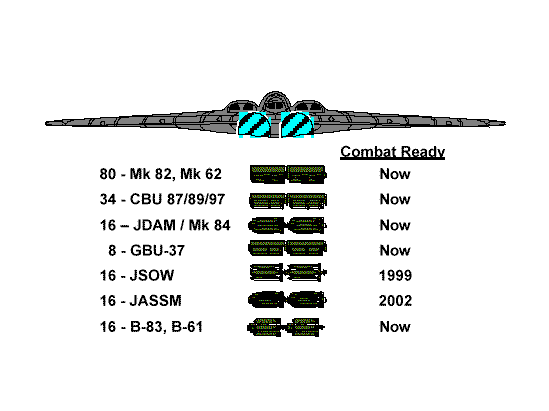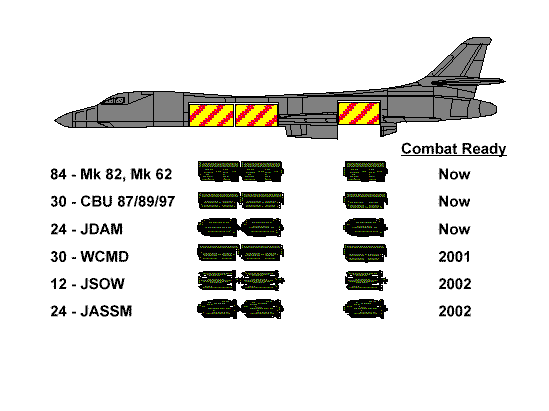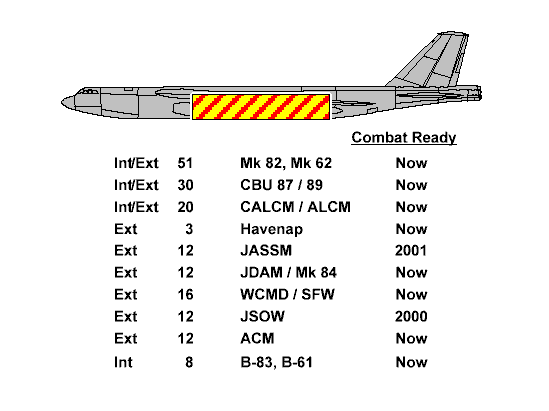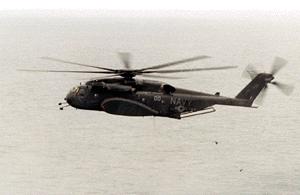Skip to comments.
Copters recalled from boneyard
http://www.newsobserver.com/news/v-printer/story/2741511p-9179104c.html ^
| Aug 21, 2005
| JAY PRICE
Posted on 08/21/2005 8:20:31 PM PDT by KneelBeforeZod
CHERRY POINT MARINE CORPS AIR STATION -- Earlier this month, a pair of hulking transport planes touched down and disgorged the newest additions to the Marine Corps helicopter fleet: three MH-53E Sea Dragons that had been sitting in an aircraft "boneyard" in the Arizona desert for about a decade. The civilian maintenance workers at Cherry Point's Naval Air Depot will clean, strip and transform the worn-out helicopters into the Marine version of the aircraft, the Super Stallion, a process that could take 20 months. This is the first time that retired choppers such as these have been resuscitated, and the challenges are unique: Not only have the helicopters been outside about 10 years, but the Super Stallion has evolved with continuous major upgrades.
Restoring the helicopters, which have been out of production since 1999, is an extraordinary step; but the Marines have little choice: They're running out of big choppers.
The wars in Afghanistan and Iraq are taking a bite out of their deteriorating helicopter fleet, not just in aircraft lost -- six Super Stallions have been destroyed in crashes since 2001 -- but also in hours that the helicopters are flying.
"They're coasting on legacy fleets," said Richard Aboulafia, an analyst with the Teal Group, an aerospace and defense consulting company in Fairfax, Va. "They planned to coast indefinitely ... and it would have worked just fine if it hadn't been for Afghanistan and Iraq."
The Super Stallion is the Corps' only heavy lift helicopter, and its workhorse. It moves large amounts of cargo and troops long distances and performs rescue missions. It can carry up to 55 Marines and can use slings to transport heavy equipment such as Humvees or even small armored vehicles.
The Marines' fleet of 150 is working hard.
The two wars have pushed helicopters into a bigger military role than at any time since the Vietnam era. In Iraq, choppers are vital not only for the usual reasons -- because they can quickly move troops, supplies and equipment between points without runways -- but also because roadside bombs have become the insurgents' deadliest weapon. In Afghanistan, roads are few, and broad swaths of rugged territory are impassable by ground vehicles.
A replacement helicopter, designated the CH-53X, is in the works; but it is not far along. The Marines hope to sign a contract this fall to begin development, said John Milliman, a helicopter acquisition programs spokesman at Patuxent River Marine Air Station in Maryland.
It will probably be at least 2015 before the replacement choppers are deployed, he said. But the service life of a Super Stallion is 6,120 hours in operation, and current estimates are that the Corps will have to start parking about 15 copters a year in 2010.
That leaves five years in which the Marines' fleet of heavy lift helicopters will dwindle before replacements start coming into service.
How will they fill the gap?
"Ask me when we get there," Milliman said. "We will cover it somehow. I know we've got great minds working on it."
Asked whether the helicopter supply would have lasted through that gap without the wars, he said: "That is a reasonable supposition."
Last week, the three dark-gray Sea Dragons sat on a concrete apron outside the Cherry Point depot's hangars, their rotor blades, exterior fuel tanks and various hatches detached. Their rear loading ramps gaped, and larger parts such as tail fins were tucked inside.
The Navy paint, which will eventually be replaced by the pale gray Marine color scheme, was faded and splotched. Inside, they had the musty smell of vintage cars.
The first will be wheeled into the hangar late this month.
"When we're done, the Marines will never know that this was a Navy bird, or that it had been sitting in storage," said Lt. Col. A.P. Camele, director of operations at the depot.
The Marine Corps has requested money to rebuild two more Stallions from the boneyard, said Capt. Jerome Bryant, a Marine spokesman at the Pentagon.
Aboulafia, the analyst, said the wars are not the only cause of the chopper shortage. He also blames the long-troubled V-22 Osprey tilt-rotor development program, the costs of which have soared.
That aircraft -- which can take off like a helicopter, then rotate its engines to go forward like an airplane -- has been in development since 1983. Its setbacks include two crashes in 2000 that killed 23 Marines and a scandal over falsified maintenance records. The program has repeatedly seemed close to being canceled, but now appears on track for full production.
The Osprey is designated a "medium-lift" aircraft, meaning it carries fewer troops and less cargo than the Super Stallion. It is planned as the replacement for the smaller CH-46 chopper.
The Marines have spent $13.4 billion on the Osprey, said Ward Carroll, a spokesman for the program. They have spent or obligated $111.8 million for the replacement for the Super Stallion, Milliman said.
"The Marines have put all their lift eggs in one basket, the V-22," Aboulafia said.
Corps officials thought buying other aircraft would not only divert money from the Osprey -- long seen by the Marines as their most important aircraft program -- but could reduce the need for the vulnerable Osprey in the eyes of budget makers in Washington, he said.
Milliman said the Osprey and the Super Stallion have little overlap in their missions. The Osprey's problems have made it a convenient target for critics, he said.
At least part of the solution to the Super Stallion shortage, Milliman said, could involve the Cherry Point depot and the 14 other rebuildable helicopters sitting in the Arizona boneyard, formally called the Aerospace Maintenance and Regeneration Center. The boneyard is a combination junkyard and storage lot for military and Coast Guard aircraft that can be brought back into U.S. service or sold to allies.
There are 4,300 aircraft there dating to 1957, and most are suitable only for parts, said Terry Vanden-Heuvel, a spokeswoman there.
Before they're stored, fuel is drained and armaments and classified systems removed. Openings are sealed with tape and paper, then spray-coated with plastic. The low rainfall and humidity and the alkaline soil hold corrosion to a minimum.
The civilian depot workers -- officials there call them artisans -- perform major maintenance on helicopters for the Navy, Air Force and Marine Corps as well as the Marines' vertical takeoff Harrier jets and the presidential helicopter fleet. They are adept at maintaining aircraft that have been out of production for decades: They fashion new parts or devise techniques to replace components originally expected to outlive the aircraft. In the giant, spotless hangar where depot workers maintain Stallions, more than a dozen sit in various states of disassembly.
Military aircraft aren't finished once they're constructed: They evolve as technology changes. Because the three Sea Dragons have been out of service for about a decade, more than 80 major system upgrades must be performed -- engine improvements, navigation equipment, and systems designed to protect the choppers from enemy missiles. When complete, the helicopters won't be considered new, but should last as long as others in the fleet with the same hours. One has about half its service life left, the others about one-third.
The task is so unusual that the depot workers will start with just one aircraft this week and build a body of experience before starting on the other two, said Dan Anthony, who is in charge of scheduling H-53 work at the depot
They'll do it at what appears to be a bargain price compared with the $105 million estimated cost for each Osprey, or the $30 million the last new Super Stallions cost in 1999.
Camele, the operations director, said the depot expects to put all three Stallions back in service in top condition for $15 million.
TOPICS: Government
KEYWORDS: boneyard; cherrypoint; clintonlegacy; helicopter; helicopters; marines; miltech; osprey; superstallion; supplylines; usmc; v22
Navigation: use the links below to view more comments.
first previous 1-20, 21-40, 41-55 last
To: Kozak
If one of the props, or the shaft between them gets shot they are unsurvivable, cant autrotate down, and glide like a paving brick. $13 billions and 25 years just to get a flying truck that is a tad faster than a helicopter... sounds foolhardy to me...!
41
posted on
08/22/2005 9:21:17 AM PDT
by
aspiring.hillbilly
(The Confederate States of America rises again...!)
To: wildcatf4f3
Old 52s bays were set up to drop 40 500 lb bombs with another 12 under the wings. those flying todayare setup for cruise missles and and a small munber of prescision weapons. They can't carpet bomb. The B2 bay was never designed for large numbers of ordnance and is cramped compared to a 52 in the interest of stealth.
Why can't they modify a big cargo plane, say a 747, with a bombbay? We don't need these to be fancy, no need for electronic countermeasures, or other defensive systems, just the ability to haul large amounts of ordinance and be able to stay on station for long duration. Should be a great way to get lots of bang for the buck in these wars against third world morons eager to meet Allah.
42
posted on
08/22/2005 10:59:08 AM PDT
by
Kozak
(Anti Shahada: " There is no God named Allah, and Muhammed is his False Prophet")
To: Tangerine Time Machine
"...We will be damn lucky to be ready for China... My thoughts exactly. What is stopping China, and it's allies from seizing the opportunity to grab Taiwan or anything they want? What the heck could we do George? We have successfully depleted what little Clinton left us with, and lost over 1800, brave military, and for what? I see Iraq in absolute chaos as soon as we leave, which may destabilize the area even more than it was before or action.
To: aspiring.hillbilly
sounds foolhardy to me...!That's an appropriate description of your ill-informed rants on this thread.
To: wildcatf4f3
The big belly
D models have all been scrapped.
To: wildcatf4f3
Old 52s bays were set up to drop 40 500 lb bombs with another 12 under the wings.Big Belly Ds, which have all been scrapped, could carry 84 Mk 82s internally and 24 externally.
The B2 bay was never designed for large numbers of ordnance and is cramped compared to a 52 in the interest of stealth.
Guess again. The B-2 can carry 80 Mk 82s internally.



To: kylaka
The Marines squandered a lot of money on this pig. Nope. The Navy had control of the purse strings. If the Marine Corps had managed the project from day one it would have been in the fleet a long time ago.
Under the right circumstances, and with a little luck, you could down it with a $5.00 slingshot.
Anything that flies can be brought down with a little luck, including the $1,000,000,000 per copy B-2.
To: A.A. Cunningham
great, thank you. but what do we have--a dozen maybe--they'd all be lost in two weeks of a real war.
48
posted on
08/22/2005 4:01:58 PM PDT
by
wildcatf4f3
(whats wrong with a draft?)
To: Finalapproach29er
"Are those 300 missing ships now razorblades?" Or perhaps weapons pointed back at us?
49
posted on
08/22/2005 4:13:09 PM PDT
by
editor-surveyor
(Atheist and Fool are synonyms; Evolution is where fools hide from the sunrise)
To: KneelBeforeZod
I was riding in a CH-53 once that emergency landed on Vieques after an engine flameout.

50
posted on
08/22/2005 4:20:10 PM PDT
by
Doohickey
(If you choose not to decide, you still have made a choice...I will choose freewill.)
To: wildcatf4f3
~16
operational.
they'd all be lost in two weeks of a real war.
No they wouldn't. Most of them would be down for maintenance after a week.
To: A.A. Cunningham
ya got me to smile---thanks
52
posted on
08/22/2005 5:59:29 PM PDT
by
wildcatf4f3
(whats wrong with a draft?)
To: A.A. Cunningham
The Osprey should have in combat for the past 10 years given the time and billions thrown at it. If 'that" isn't the case, the project was foolhardy by any sane measure.
53
posted on
08/23/2005 10:16:19 AM PDT
by
aspiring.hillbilly
(The Confederate States of America rises again...!)
To: aspiring.hillbilly
Instead of simply flapping your gums try getting an education. You know not of what you rant about.
To: kylaka
"Under the right circumstances, and with a little luck, you could down it with a $5.00 slingshot."
In other words, it's like any other helicopter.
Once upon a time, the Marine Corps rode H-46s in Vietnam. Those birds often had THE ENTIRE BACK END FALL OFF during an approach to a landing zone.
Now, the replacement aircraft's had problems. It looks like the Marine Corps fixed the big ones.
Navigation: use the links below to view more comments.
first previous 1-20, 21-40, 41-55 last
Disclaimer:
Opinions posted on Free Republic are those of the individual
posters and do not necessarily represent the opinion of Free Republic or its
management. All materials posted herein are protected by copyright law and the
exemption for fair use of copyrighted works.
FreeRepublic.com is powered by software copyright 2000-2008 John Robinson



